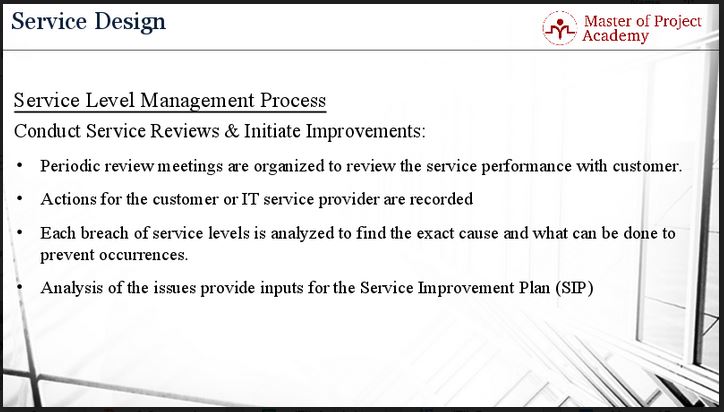Within the ITIL framework, Service Level Agreements (SLAs) are the contract between an IT service provider and its customer in which service level targets are set to stipulate the quality of service that will be provided by the IT service provider. SLA management is critical to ensure that these SLAs are kept up to date and that the agreed performance standards for the service levels are not breached. This is the role of SLA management in ITIL as discussed in ITIL foundation training and other online ITIL courses. SLA management forms part of the larger service level management theme.

Reviews of service level targets
Services provided in a live environment should be monitored closely through SLA management to check whether the service meets the service level targets agreed on in the SLA. SLAs are strictly formulated to stipulated exactly what the service level targets are that need to be met by the IT service provider. SLA management ensures that the SLAs stay up to date and to do so it is necessary to have reviews of the service achievements and that periodic review meetings must be held with the customer. During these SLA management meetings, the performance of every service provided to the customer is analyzed and checked whether the services met the desired service level targets as agreed in the SLAs.
Sometimes, due to changes in the market or due to capacity constraints, it is not possible to reach the desired service level targets. During a service level review, it can be established that the service level targets have not been met, but it is not immediately possible to say what exactly is the reason for the breach in service levels. Only proper root cause analysis can identify the point of pain. At first glance, the reason for the breach may be one problem, but root cause analysis may identify the real problem which might be something that no-one on the team has thought of initially. It is important for SLA management that the root cause of problems to reach the service level targets are accurately identified.

Root Cause Analysis
If it is found through SLA management that a service could not meet its service level targets, appropriate action must be allocated to the customer and/or to the IT service provider and these actions must be documented officially. For instance, if a service could not meet the 98% availability service level target, the reason of this breach should be analyzed and the root cause must be found. Root cause analysis of breached services is a critical part of SLA management.

During SLA management, particular attention should be focused on each breach of service level to determine the exact cause and what can be done to prevent any recurrence. For instance, if the breach of the service availability service level target is due to the supplier that could not meet its service levels, then actions must be taken on the partner or supplier side during the SLA management phase. Or, if the root cause of the breach is a lack of power of the servers providing this service, strengthening the servers of the service should be taken as an action to avoid this breach in future.
SLA management is the responsibility of both the IT service provider and the customer. Every breach of the service level targets are analyzed and a root cause for not meeting the service level targets must be found. Then appropriate actions must be taken in order to not have this breach in future and so that the planned service delivery quality to the customers can be provided.
It is critical that the corrective action is taken based on proper root cause analysis and not just on what the team thinks may have gone wrong. Proper root cause analysis will ensure that the problem will be fixed. Trying to fix a problem by not addressing the root cause, but rather some other probable cause will not fix the problem and can cost the company money and also indirectly cause loss of sales.
SLA Management: Service Improvement Plan
These analyses provide a valuable input for the Service Improvement Plan (SIP) – a critical part of SLA management. A Service Improvement Plan is a formal plan to implement improvements to a process or IT service. A service improvement plan consists of several elements:
- Process or service of concern
- Person in charge of the service (service owner)
- Initiative owner (service manager)
- Priority
- Approval from senior management
- Description of the initiative
- Source of the measure e.g. service review
- Business case with expected outcome, costs, and desired result
- Implementation schedule with milestones, key deliverables, persons in charge, target completion dates, and current status
As an IT service provider, you plan, design, implement, test and deploy services for the use of customers. But depending on the demand for these services or the evolution of the competition in the market improvements, changes to these services may be required. A SIP is a useful tool in SLA management when changes in a service are required.
Effective SLA management identifies these changes and implements it by changing service level targets. If the IT service provider cannot catch these demands and competition in the market, it will be very hard for the organization to ensure a sustainable business in the market. SLA management ensures that the company stays competitive in the market.
Therefore, SLA management is applied: services are monitored, reviewed and analyzed regularly to find improvement points and steps. Thus, if a service is not meeting its service level targets, these improvement points and steps might be coming from the analysis of the root cause of the service level breaches. These steps must be followed to ensure that the service level breach will not occur again.
Proper SLA management ensures that the service level targets are met consistently and that any breaches in service levels are promptly dealt with. Neglecting SLA management and regular reviews of service level targets will result in non-performing services to keep having a negative impact on the business. If you want to have a brief look into ITIL concepts such as SLA management, you may consider enrolling in a free ITIL training.
Review by: Marie Marshall
